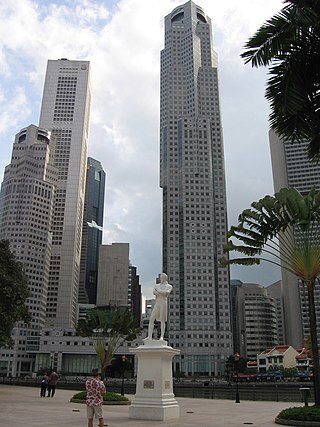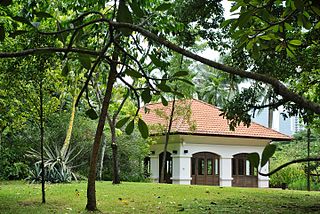Events from the year 1823 in Singapore .
Contents
| |||||
| Decades: | |||||
|---|---|---|---|---|---|
| See also: | |||||
Events from the year 1823 in Singapore .
| |||||
| Decades: | |||||
|---|---|---|---|---|---|
| See also: | |||||

Sir Thomas Stamford Bingley Raffles was a British colonial official who served as one of the British Governors of the Dutch East Indies between 1811 and 1816, and Lieutenant-Governor of Bencoolen between 1818 and 1824.

Raffles Institution (RI) is an independent educational institution in Singapore. Founded in 1823, it is the oldest school in the country. It provides secondary education for boys only from Year 1 to Year 4, and pre-university education for both boys and girls in Year 5 and Year 6. Since 2007, RI and its affiliated school Raffles Girls' School have been offering the six-year Raffles Programme, which allows students to skip the Singapore-Cambridge GCE O-Level examinations and proceed to take the Singapore-Cambridge GCE A-Level examinations at the end of Year 6.

William Farquhar was a Scottish colonial administrator employed by the East India Company, who served as the sixth Resident of Malacca between 1813 and 1818, and the first Resident of Singapore between 1819 and 1823.

The Jackson Plan or Raffles Town Plan, an urban plan of 1822 titled "Plan of the Town of Singapore", is a proposed scheme for Singapore drawn up to maintain some order in the urban development of the fledgling but thriving colony founded just three years earlier. It was named after Lieutenant Philip Jackson, the colony's engineer and land surveyor tasked to oversee its physical development in accordance with the vision of Stamford Raffles for Singapore, hence it is also commonly called Raffles Town Plan. Raffles gave his instructions in November 1822, the plan was then drawn up in late 1822 or early 1823 and published in 1828. It is the earliest extant plan for the town of Singapore, but not an actual street map of Singapore as it existed in 1822 or 1827 since the plan is an idealised scheme of how Singapore may be organised that was not fully realised. Nevertheless, it served as a guide for the development of Singapore in its early days, and the effect of the general layout of the plan is still observable to this day.

The Downtown Core is the historical and downtown centre of the city-state of Singapore and the main commercial area in Singapore excluding reclaimed lands with many integrated resorts such as the Marina Bay Sands, one of the most expensive buildings in the world, with a luxurious standalone casino at Bayfront Avenue. There are many skyscrapers in Raffles Place, Tanjong Pagar and Marina Bay CBD with a height limit of 280m. It is one of the eleven planning areas located within the most urbanised Central Area, forming the latter's dense urban core. It is bounded by Rochor to the north, Kallang to the northeast, Marina East and Marina South to the east, Straits View to the southeast, Bukit Merah to the south, as well as Outram, Museum and Singapore River to the west.

The establishment of a British trading post in Singapore in 1819 by Sir Stamford Raffles led to its founding as a British colony in 1824. This event has generally been understood to mark the founding of colonial Singapore, a break from its status as a port in ancient times during the Srivijaya and Majapahit eras, and later, as part of the Sultanate of Malacca and the Johor Sultanate.


Fort Canning Hill, formerly Government Hill, Singapore Hill and Bukit Larangan, or simply known as Fort Canning, is a prominent hill, about 48 metres (157 ft) high, in the southeast portion of Singapore, within the Central Area that forms Singapore's central business district.


George Drumgoole Coleman, also known as George Drumgold Coleman, was an Irish civil architect who played an instrumental role in the design and construction of much of the civil infrastructure in early Singapore, after it was founded by Sir Stamford Raffles in 1819. Only a few of his buildings have survived in Singapore, most notably Armenian Church of Saint Gregory the Illuminator, Maxwell's House, and Caldwell House.
Philip Jackson was a British Royal Navy lieutenant in the Bengal Regiment Artillery. Jackson has also served as assistant engineer, executive officer and surveyor of public lands in colonial Singapore and laid out the city plan for Singapore in 1822. He was a key person in Raffles plans for the settlement and the Elgin Bridge in Singapore was once named in his honour.

Bras Basah Road is a one-way road in Singapore in the planning areas of Museum and Downtown Core. The road starts at the junction of Orchard Road and Handy Road, at the ERP gantry towards the Central Business District, and ends at the junction with Nicoll Highway, beyond which it becomes Raffles Boulevard. Several landmarks including Fairmont Singapore, Raffles Hotel, Singapore Art Museum, Cathedral of the Good Shepherd and the Singapore Management University are located along the road. A MRT station with the same name, Bras Basah MRT station, is on the Circle Line.
Sir Robert Townsend Farquhar, 1st Baronet was an influential British merchant of the early nineteenth century who served as a colonial governor and Member of Parliament. During his lengthy service for both the East India Company and the British government, Farquhar gained a reputation as an efficient and ambitious administrator and he notably served as Lieutenant-Governor of Prince of Wales Island from January 1804 to 1805 and as governor of Île de Bourbon, now known as Réunion from 1810 to 1811.
William Edward Phillips (1769–1858) was a British army officer and colonial administrator. He was acting governor of the Prince of Wales' Island on numerous occasions.
Events from the year 1819 in Singapore.

The William Farquhar Collection of Natural History Drawings consists of 477 watercolour botanical drawings of plants and animals of Malacca and Singapore by unknown Chinese artists that were commissioned between 1819 and 1823 by William Farquhar. The paintings were meant to be of scientific value with very detailed drawings, except for those of the birds which have text going beyond their original purpose. For each drawing, the scientific and/or common name of the specimen in Malay, and, occasionally, in English, was written in pencil. A translator also penned the Malay names in Jawi using ink. The paper used was normally European paper framed by a blue frame while some have no frames at all suggesting there are two artist.

Raffles House is a single-storey building built on the Fort Canning Hill, Singapore. The original building was a wood and atap structure built in 1822 that was used as a place of residence by Sir Stamford Raffles. This building was later rebuilt as a neoclassical-styled Government House as the residence of subsequent colonial governors, but it was demolished in 1858 to make way for the construction Fort Canning. The present structure built on the same site is a brick and tile building constructed in 2003.
Dato Temenggong Daeng Abdul Rahman bin Tun Daeng Abdul Hamid was the Temenggong of Johor during the Bendahara dynasty. He was best known of being instrumental in the Treaty of Singapore with the British East India Company in 1819.
Francis James Bernard was the first police chief of the Police Force in Singapore and the founder of the Singapore Chronicle, the first newspaper in Singapore.